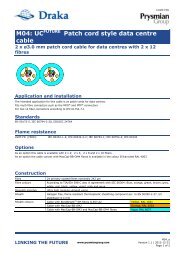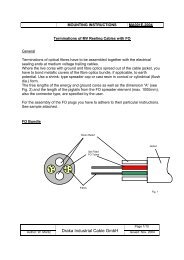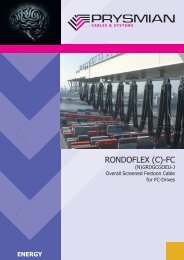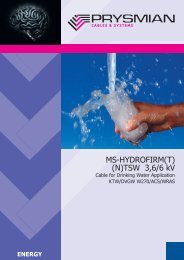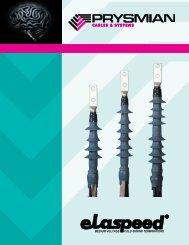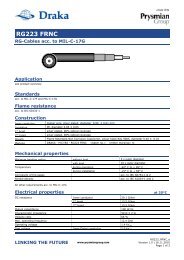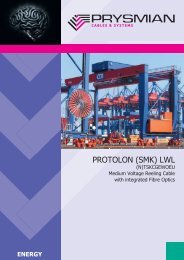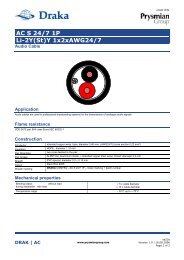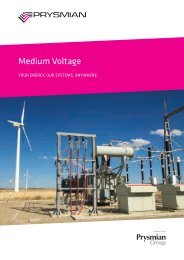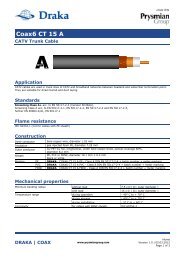Create successful ePaper yourself
Turn your PDF publications into a flip-book with our unique Google optimized e-Paper software.
GENERAL INFORMATIONThe MIMS and Firestop cable ranges are for use where circuit integrity under fire conditions is important and where flame propagation,evolution of smoke, acid emissions and noxious gases are to be minimised to reduce <strong>the</strong> risk to personnel and equipment.COMPLIANCE WITH APPROVALS AND STANDARDSThe Firestop cable range is manufactured to AS/NZS 5000.1 (where applicable). The Firestop range meets <strong>the</strong> requirements of <strong>the</strong>following Standards:• AS/NZS 3000 – Australian/New Zealand Wiring Rules• AS/NZS 3013 – Electrical installations – classification of <strong>the</strong> fire and mechanical performance of wiring system elements• AS/NZS 4507 – Classification CI-1• AS/NZS 2293.1 – Emergency escape lighting and exit signs for buildings – System design, installation and operation<strong>Prysmian</strong> Cables Australia maintains Quality Certification to AS/NZS ISO 9001.CURRENT RATINGSFirestop FS90 are insulated with X-90 XLPE and have a maximum conductor operating temperature of 90°C. Firestop Flat FS90 areinsulated with HFI-90-TP and have a maximum conductor operating temperature of 75°C. Air ambient temperature of 40°C, orground ambient temperature of 25°C is assumed.Firestop FS110 cables are insulated and shea<strong>the</strong>d with materials having superior <strong>the</strong>rmal endurance properties. The cables arecapable of operating continuously at a conductor temperature of 110°C. If intended for use in non-metallic wiring enclosure, currentrating for 90°C shall be applied.The current ratings of <strong>the</strong>se cables relate to single circuits and align with AS/NZS 3008.1.1 cables for alternating voltages up to 0.6/1kV.INSTALLATION GUIDELINES FOR FIRESTOP CABLES FS90 AND FS110Unless stated in <strong>the</strong> standards detailed below, installation and WS rating shall be as per AS/NZS 3000.• AS/ACIF S009:2006 – Installation requirements for customer cabling (Wiring Rules)• AS 1530.4-2005 – Methods for fire tests on building materials,components and structures – Fire-resistance test of• AS/NZS 1668 – The use of ventilation and airconditioning in buildings• AS/NZS 1668.1:1998 – The use of ventilation and airconditioning in buildings – Fire and smike control in multi-compartments• AS 1670.1 – Fire detection warning, control and intercom systems – System design, installation and commisioning – Fire• AS/NZS 1680.2.4:1997 – Interior lighting – Industrial tasks and processes• AS 1735.2-2001 – Lifts, escalators and moving walks – Passenger and goods lifts – Electric• AS 2118 – Automatic fire sprinkler systems• AS 2118.1-2006 – Automatic fire sprinkler systems – General systems• AS 2118.2-1995 – Automatic fire sprinkler systems – Wall wetting sprinklers (Drenchers)• AS 2118.4-1995 – Automatic fire sprinkler systems – Residential• AS 2118.5-1995 – Automatic fire sprinkler systems – Domestic• AS 2118.6-1995 – Automatic fire sprinkler systems – Combined sprinkler and hydrant• AS 2067-2008 – Substations and high voltage installations exceeding 1 kV a.c.• AS 2293 – Emergency escape lighting and exit signs• AS 2293.1-2005 – Emergency escape lighting and exit signs for buildings – System design, installation and operation• AS 2941-2002 – Fixed fire protection installations – Pumpset systems• AS 2941-2008 – Fixed fire protection installations – Pumpset systems• AS/NZS 3000:2007 – Electrical installations (known as <strong>the</strong> Australian/New Zealand Wiring Rules)• AS/NZS 3009:1998 – Electric installations – Emergency power supplies in hospitals• AS 3772-2008 – Pre-engineered fire protection systems for cooking equipment• AS 4118.1.4-1994 – Fire sprinkler systems – Components – Valve monitors• AS/NZS 4507:2006 – Cables – Classification of characteristics when exposed to fire19




